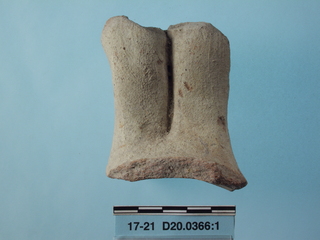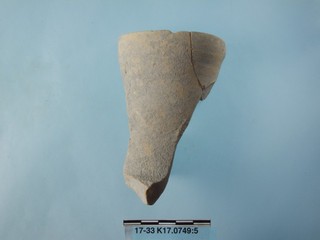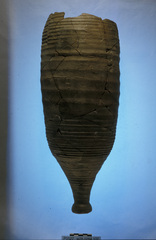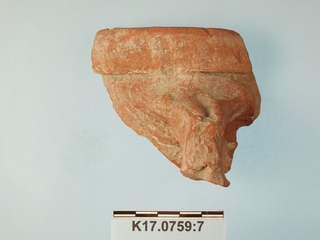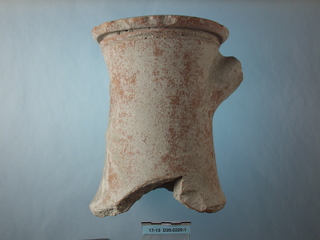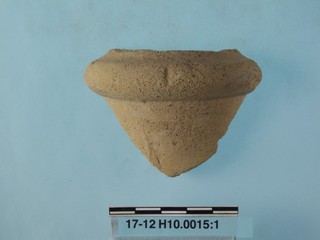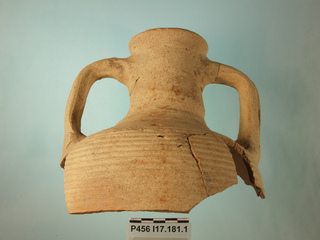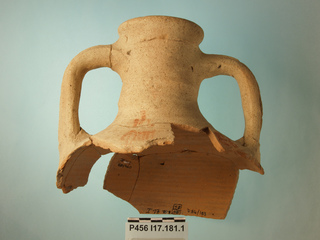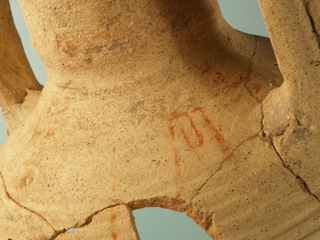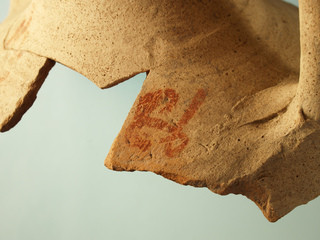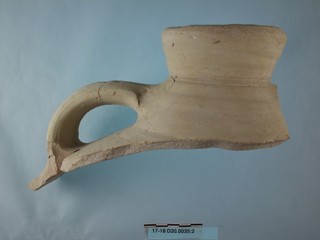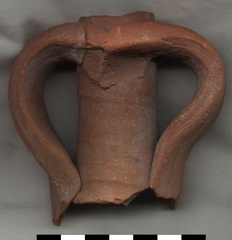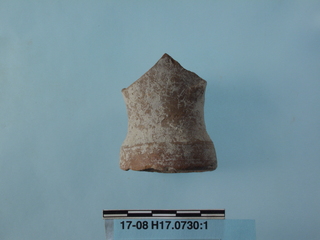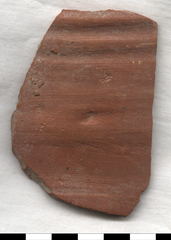Greek, Roman and Byzantine Pottery at Ilion (Troia):
Sebastian Heath and Billur Tekkök, Editors
Roman Amphoras
Please note that this is a public draft of work in progress
The following catalog lists a small sample of the Roman-period amphoras found at Troia. The separation of Hellenistic from Roman is somewhat arbitrary and begins here with the forms Dressel 1, Dressel 2-4 and Dressel 6. In the references, “Middle Roman” amphoras are classified according to the typology established by Riley () at Benghazi, ancient Berenice. “Late Roman Amphora” indicates use of the overlapping typology developed at Carthage (), itself derived from earlier work at Caesarea (). Of the types defined by Riley, MRA 5 and MRA 7 are relatively common in the late second and third centuries. MRA 5 begins to appear in the late second century. Slane (:364-365) suggests that the introduction of MRA 7 be dated to the early third century. Martin (:429-430) records the form as still in use at Olympia in the late fourth century. There are two main fabrics of this form: one brown with frequent light angular inclusions, the other brick-red with occasional dark rounded stones visible in the fabric and on the surface. A third fabric, so far represented by a single sherd with dark surface, also appears below. Pontic amphoras occur in middle roman deposits at Troia. The one-handled MRA 3, known as "micaceous water jar", likewise occurs regularly. Its two handled successor, LRA 3, is present in later levels. Two "pinched handle" amphoras, one perhaps in Cilician fabric, are described below; as is a single Cretan amphora. In the later series of eastern Mediterranean amphoras, the Cilician/Cypriot LRA 1, Aegean LRA 2, W. Anatolian LRA 3, and Gazan LRA 4 all appear at Ilion. No examples of LRA 5/6 or LRA 7 have been recorded. As is often the case on eastern Mediterranean sites, North African amphoras are very rare, though one piece, a spatheion toe, is published here and a few others have been cataloged.
1. Unclassified Dressel 1 Type Amphora (1st Century BC)
P. H. .093. Est. diam. rim .18 (1/10 preserved). Th. .015.
K/L16/17.0427:40. Single sherd with rim, upper neck, and handle attachment. The light red (2.5YR 7/6) fabric is compact with many large rounded bits of previously fired red (2.5YR 5/8) clay as much as .004 in length but mostly much smaller. There are other angular and rounded inclusions that are both light and dark. Just beneath the surface, the fabric is fired light green gray (2.5Y 6/2). The plain surface is buff (2.5Y 8/2).
svg/K-L16-17.0427-40.jpg
2. Dressel 6 Amphora (Augustan)
P. H. .093. Est. diam. rim .166.
D08.0695:5. SC16-06. Single rim sherd. Light buff (10YR 8/2) surface, smooth. Well defined light reddish-brown core (2.5YR 7/4).
First published as no. 53. The form is generally 50 BC to 150 AD; this example comes from an Augustan deposit.
3. Dressel 2-4 Amphora Handle, probably Campanian (1st to 3rd Century AD)
W. .057.
D20.0366:1. SC17-21. Single sherd, handle and neck attachment. Hard, granular fabric is red with many dark and red grits. Surface coated buff.
Class 3. A similar piece is published at no. 109.
4. Cretan Amphora Neck with Handle Stub, Type AC1b (2nd and 3rd century AD)
P. H. .104. Est. diam. rim .07 (3/4 preserved). Th. .0062.
K17.0749:5. SC17-33. Three sherds with rim and handle stub. Compact, soft pale brown (7.5YR 7/4) fabric with occasional small calcareous inclusions. Surface is coated and paler (7.5YR 8/3). Slightly conical neck and slightly thickened rim.
See AC1b, pp. 70-72; particularly p. 75 for chronology; closest parallels for profile are A37 and A42-44 on fig. 37. See also Middle Roman Amphora 2, pp. 180-183; particularly no. D226; class 41.
svg/K17.0749-4.jpg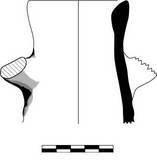
5. Middle Roman Amphora 3 (“Micaceous Water Jar”) Neck with Handle Stub
P. H. .08. Th. .003.
K17.0752:3. SC17-34. Single sherd, incomplete rim and single handle attachment. Fabric and surface brown (2.5 YR 5/4), with frequent mica.
, pp. 183-186; class 45 combines the one and two-handled versions; , plate 41.
svg/K17.0752-3.jpg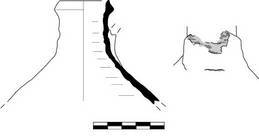
6. Middle Roman Amphora 3 (“Micaceous Water Jar”) Neck with Handle Stub
w28.0264.102. P0527. Micaceous brown fabric (2.5YR 4/4 to 5YR 4/4). Non-joining neck, rim and single handle are preserved, though not shown in drawing (tk).
, pp. 183-186; class 45 combines the one and two-handled versions; , plate 41.
svg/P0527.jpg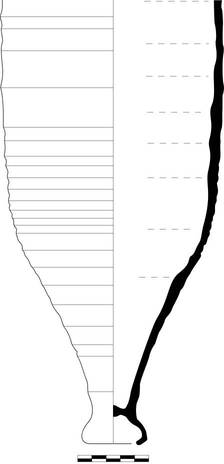
7. Water Jar Toe, Regional? (Mid Roman)
P. H. .117. Est. diam. base .067 (completely preserved). Th. .0095.
K17.0881:7. Compact fabric, brown (5YR 6/8). Frequent tiny mica and few tiny dark inclusions. Buff surface with drippping paint visible under accretion.
K17.0881-7.jpg
8. Middle Roman Amphora 4 ("Pinched Handle") Rim and Handle
P. H. .073. Est. diam. rim 11 (1/3 preserved). Th. .005.
K17.0759:7. Single sherd. Dark brown (2.5YR 5/8) fabric with infrequent tiny dark and light inclusions. The surfaces are coated and fired to the same color as the fabric. The extant handle is pinched where it turns down towards the body.
For an overview of the form see , pp. 186-187. The fabric of this piece is perhaps identical to that of Cilician “pinched handle” amphoras as described and illustrated in color at , pp. 329-332. Similar fabric and profile at Knossos ().
svg/K17.0759-7.jpg
9. Middle Roman Amphora 4 ("Pinched Handle") Rim and Handle
P. H. .087. Est. diam. rim 11 (1/3 preserved). Th. .005.
K17.0780:1. Four joining sherds with rim and one handle. Soft, compact, pale green (2.5Y 8/2) fabric. The frequent inclusions include occasional large angular quartz (.005 in length), rounded lime, chunks of previously fired clay that are more red than the main matrix, and a variety of smaller inclusions. Elongated voids in wall, irregular voids in handle. The surface is plain. Handle is “pinched” at upper angle. The sherds have been conserved.
For an overview of the form see , pp. 186-187. Cf. , no. G199 and , no. 41.
K17.0780-1.jpg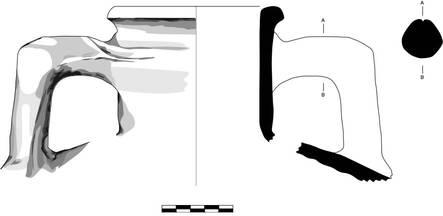
10. Middle Roman Amphora 5 Neck, Rim and Handle
P. H. .115. Est. diam. rim .15 (1/5 preserved). Th. .01.
K17.0759:8. Single sherd with rim and handle, single groove under rim. Coarse fabric. Gray core where wall is thickest but cleanly fired to red (from 2.5YR 5/8 to 2.5YR 6/6) at lower extant neck. Coated exterior surface is brown (2.5YR 5/6) after conservation. Small lime/white bits and angular sand are the most frequent inclusions.
, pp. 188-189.
svg/K17.0759-8.jpg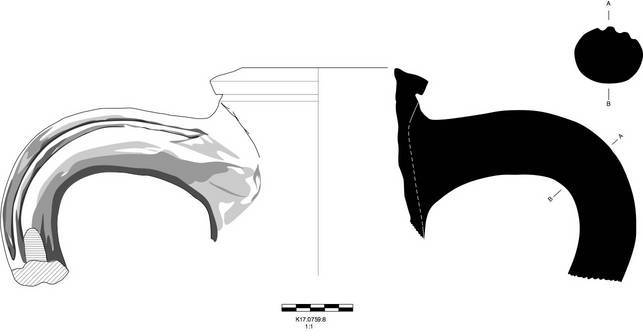
11. Middle Roman Amphora 5 Neck and Rim
D20.0220:1. SC17-13. Single large piece preserving neck and rim. High neck. Flattened rim. Two deep incisions below rim. Core- pink/gray (5YR 6/2) fired to red (2.5YR 5/6). Quartz and other angular inclusions.
, pp. 188-189.
12. Middle Roman Amphora 5 Rim
D20.0017:34. SC17-14. Single rim sherd. Two deep exterior incisions. Light brown/gray (10YR 6/2) core fired to light red (2.5 YR 6/8) at surface. Large light inclusions.
, pp. 188-189.
13. Middle Roman Amphora 7 Rim and Handle
P. H. .11. Est. diam. rim .06 (completely preserved preserved). Th. .0065.
K17.0759:9. Single sherd, rim and handle. Well-formed collar below rim. Coarse fabric. Reddish-brown (2.5YR 6/8) fabric with frequent rounded and sub-angular black stones up to .002 in length, as well as frequent small white and varied bits; elongated voids. Surface is coated and ranges from 2.5YR 6/6 to a smokey dull red (2.5YR 5/3 and darker). Sherd has been conserved.
, pp. 189-193; 77; class 47.
svg/K17.0759-9.jpg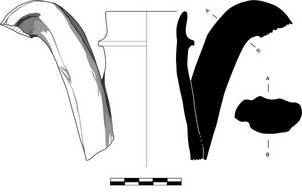
14. Middle Roman Amphora 7 Neck and Rim
P. H. .24. Est. diam. rim .061.
D20.0017:35. SC17-16. Single large piece preserving neck an rim. Brick red fabric.
, pp. 189-193; 77; class 47.
15. Middle Roman Amphora 7 Base
P. H. .165. Th. .008.
K/L16/17.0072:2. Single sherd preserves complete hollow base with lower wall. Slightly granular, brown (7.5YR 6/6) fabric with frequent angular light inclusions, fewer dark, and other mostly light bits. There is some uneven firing, lower wall gray towards interior. Surface coated and redder (5YR 6/4).
, pp. 189-193; 77; class 47.
svg/K-L16-17.0072-2.jpg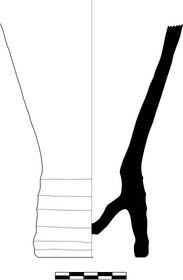
16. Middle Roman Amphora 7 Handle
K/L16/17.0072:4. Single sherd, arched handle to turn.
, pp. 189-193; 77; class 47.
svg/K-L16-17.0072-4.jpg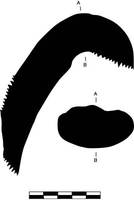
17. Middle Roman Amphora 7 Base
D20.0017:36. SC17-17. Two joining sherds, preserving base. Brick red fabric.
, pp. 189-193; 77; class 47.
18. Middle Roman Amphora 7 Base
P. H. .064. Th. .011.
E/F10.0233:13. Single sherd preserves portion of hollow toe. Granular fabric is unevenly fired in extant portion: comparatively pink (2.5YR 7/6) towards the interior, pale green (7.5YR 8/6) towards the exterior. The most visible inclusions are large (.0054) chunks of possibly re-fired clay. The largest of these are pale in comparison to their matrix, there are also smaller comparatively brick red chunks, which tend to be smaller. Taken together these inclusions are frequent. There are also tiny darker and light bits. The interior surface is coated and also pink (2.5YR 7/6). The coated outer surface is a distinctly darker reddish-brown (2.5YR 5/3).
, pp. 189-193; 77; class 47.
19. Pontic Amphora S IVb/c Rim and Handle (2nd to 4th century AD)
P. H. .125. Est. diam. rim .08 (completely preserved preserved). Th. .0094.
K17.0881:8. Neck with beginning of one handle. Pale (2.5Y 8/3) fabric with very frequent small black inclusions, interspersed with far fewer red chunks. Surface thinly coated to very similar color.
See , pp. 413-415 and fig 7 for discussion of form. Also, , p. 255, type C.
svg/K17.0881-8.jpg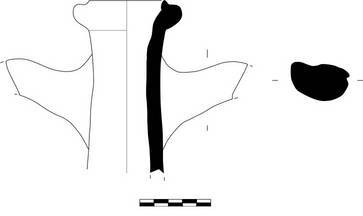
20. Pontic Amphora S IVb/c Rim (2nd to 4th century AD)
D20.0017:26. SC17-11. Single rim sherd. Pale yellow fabric with frequent dark inclusions.
See , pp. 413-415 and fig 7 for discussion of form. Also, , p. 255, type C. A complete example is illustrated from Knossos ().
svg/D20.0017-26.jpg
21. Pontic Amphora S IVb/c Rim (2nd to 4th century AD)
H10.0015:1. SC17-12. Single rim sherd. Pale yellow fabric with frequent dark inclusions.
See , pp. 413-415 and fig 7 for discussion of form. Also, , p. 255, type C.
22. Pontic Amphora S IVb/c Toe (2nd to 4th century AD)
P. H. .04. Est. diam. toe .08. Th. .005.
K17.0777:30. Toe with beginning of body. Pale fabric (7.5YR 7/4) with frequent subangular dark bits.
See , pp. 413-415 and fig 7 for discussion of form. Also, , p. 255, type C.
svg/K17.0777-30.jpg
23. Unclassified Amphora
P. H. .09. Est. diam. rim .05 (1/2 preserved). Th. .005.
K17.0759:2. Single sherd with rim and neck, stub of round handle. Slightly granular, light brown (5YR 6/8) fabric with occasional light "quartz" and varied smaller angular inclusions. Coated surface is lighter (5YR 7/4). Thickened, slightly flaring triangular rim.
svg/K17.0759-2.jpg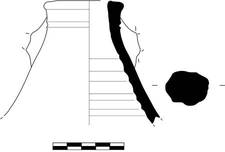
24. Unclassified Transport Amphora (Early Roman?)
P. H. .049. Est. diam. rim .15 (1/8 preserved). Th. .015.
K/L16/17.0427:34. Single rim sherd. Slightly granular fabric fired to uneven light reddish-brown (10R 6/8), thin core is lighter towards green; some small angular and rounded light, sandy inclusions, as well varied smaller bits. Surface plain. Bulbous neck with thickened rim, groove just below tip.
Dated by 2nd century closing date of context.
svg/K-L16-17.0427-34.jpg
25. Unclassified/Regional Amphora Rim and Handle (3rd Century AD)
P. H. .35. Est. diam. rim .158. Est. diam. toe .09.
. P0426. Tapering rim. Handles round in section, attached to body just below rim. Brick-red fabric (2.5YR 5/8-6/8), gritty surface. Inclusions consist of opaque white stones, black particles (volcanic), and red stone; sand tempered. A coin of Gallienus was attached to this amphora.
First published as no. 167.
svg/P0426.jpg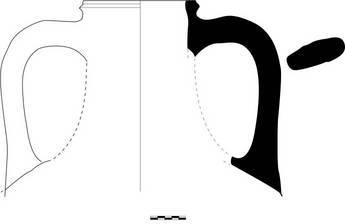
26. Pontic Late Roman Amphora 2 Precursor?
M18.0099:5. Two joining rim sherds. Relatively compact, light red (2.5YR 6/8) fabric with occasional dark grits in addition to tiny white/lime bits. The coated surface is pale.
Similar form at no. 168. That piece is from third century layer of the w28 well.
M18.0099-5.jpg
27. Late Roman Amphora 1 Neck and Handles (Late Fifth to Early Sixth Century AD)
P. H. .19. Est. diam. rim .095.
I17.0181:1. Six joining sherds preserve neck, handles and upper body. Reddish fabric (5YR 7/6) fabric becoming buff () towards surface. Frequent varied inclusions, with some occasional lime chunks. Surface smoothed and coated in places. Convex band below rim, two light channels on handles. Upper body preserves ridges as opposed to the wide bands that appear on later versions. Deposition may be associated with the early sixth century earthquake. Dipinti on both sides and under one handle.
28. Late Roman Amphora 1 Base
P. H. .095.
K17.0736:10. Single base sherd, ribbing on interior and exterior. Diameter is estimated maximum preserved diameter of body. Fabric light red (2.5YR 6/8) with very frequent light and dark bits; exterior is encrusted, interior fired pink (2.5YR 8/4). Found in post-earthquake deposit of the early sixth century AD.
K17.0736-10.jpg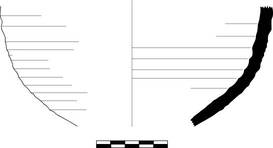
29. Late Roman Amphora 2 Neck and Handle
D20.0035:2. SC17-18. Neck and one handle preserved.
, pp. 217-219, the form is "Late Roman Amphora 2" at both Benghazi and Carthage; class 43.
30. Late Roman Amphora 2 Rim
P. H. .08. Est. diam. rim .125 (1/5 preserved). Th. .009.
K17.0696:18. Single rim sherd. Red core in thickest part of rim (2.5YR 5/6), fired brown under surface (7.5YR 6/6). Inclusions consist of occasional sub-angular dark bits, occasional lime and frequent other small varied bits. Surface is coated pale brown, near fabric.
, pp. 217-219, the form is "Late Roman Amphora 2" at both Benghazi and Carthage; class 43.
svg/K17.0696-18.jpg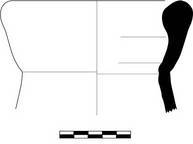
31. Late Roman Amphora 3 ("Micaceous Water Jar") Neck and Handles (Late 4th to 5th Century AD)
P. H. .091. Th. .004.
D20.0053:2. SC17-07. Neck and handles preserved, rim chipped. Micaceous brick red fabric (2.5YR 4/4) with lime inclusions.
, pp. 229-230, where the form is "Late Roman Amphora 10"; class 45 combines the one and two-handled versions; , plate 41.
32. Late Roman Amphora 3 ("Micaceous Water Jar") Toe
P. H. .048. Est. diam. base .042 (1/1 preserved). Th. .0032.
D20.0017:41. SC17-23. Single sherd. Brown, micaceous fabric.
, pp. 229-230, where the form is "Late Roman Amphora 10"; class 45 combines the one and two-handled versions; , plate 41.
33. Late Roman Amphora 3 ("Micaceous Water Jar") Fragment
Th. .005. L. .078. W. .057.
D20.0017:41. SC17-23. Body sherd. Brown, micaceous fabric.
, pp. 229-230, where the form is "Late Roman Amphora 10"; class 45 combines the one and two-handled versions.
34. Late Roman Amphora 4 (2nd quarter 5th to 500 AD)
P. H. .11. Est. diam. rim .135 (1/8 preserved). Th. .008.
K17.0736:4. SC17-35. Two joining sherds preserving rim and handle. Brown (5YR 5/6) fabric with large calcareous inclusions as well as frequent darker bits and small voids. The coated surfaces are slightly darker brown than the fabric. Rounded rim with slight inner channel. (Note: image does not show join with handle.)
The rim form matches type LRA 4B1, p. 104 and fig. 66. Cf. , pp. 219-223, where the form is "Late Roman Amphoras 3"; class 49.
svg/K17.0736-4.jpg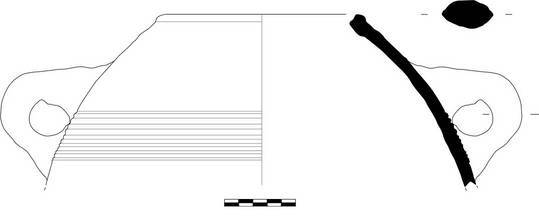
35. Late Roman Amphora 4 (“Gaza Amphora”) Handle and Upper Body
P. H. .21. Th. .009.
K17.0759:10. Single body sherd with handle attached. Compact, brown (5YR 5/6) fabric. Compact but with occasional lime chunks and other tiny black and light bits. Ridges on shoulder under handle, which suggests a fifth century date . The stance and diameter shown in the illustration are approximate.
Cf. , pp. 219-223, where the form is "Late Roman Amphoras 3"; class 49.
svg/K17.0759-10.jpg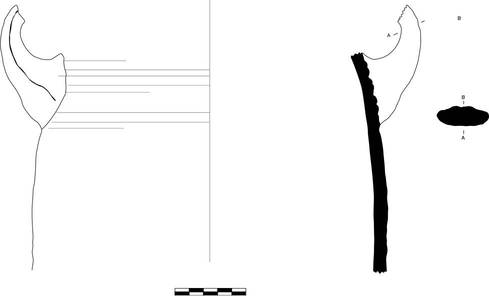
36. Late Roman Amphora 8 Rim
P. H. .048. Th. .005.
D20.0053:11. Two joining sherds. Thickened rim with triangular profile. Fabric is reddish brown (5YR 5/4) with frequent light and inclusions and frequent mica.
Cf. , p. 132-137.
37. North African Amphora Toe, Spatheion (350 to 600 AD)
P. H. .14. Est. diam. toe .032.
M18.0657:1. Single sherd preserving part of tapering toe to just above beginning of wall. Hard, slightly granular fabric is fired red (10R 5/8) with angular light inclusions. Surface of toe has streaky "salt slip". At the level of the wall, the start of vertical smoothing marks is visible. Extant interior is plain.
, p. 143.
M18.0657-1.jpg
General Bibliography
1989.
Amphores romaines et histoire économique, dix ans de recherche: actes du colloque de Sienne (22-24 mai 1986) Collection de l'École française de Rome 114. Rome.
[
worldcat.org]
Bezeczky, Tamás. 2005.
“Late Roman Amphorae from the Tetragonos-Agora in Ephesos” in
Friedrich Krinzinger (ed.), Spätantike und mittelalterliche Keramik aus Ephesos, Wein: 203-223.
Eiring, Jonas
and John Lund. 2004.
Transport Amphorae and Trade in the Eastern Mediterranean. Acts of the international colloquium at the Danish Institute at Athens, September 26-29, 2002. Aarhus.
[
worldcat.org]
Empereur, J.-Y.
and Y. Garlan. 1986.
Recherches sur les amphores Grecques Bulletin de Correspondence Hellénique Supplement 13. Athens.
[
worldcat.org]
Keay, Simon
and David Williams. 2005.
Roman Amphorae: a digital resource..
[
online]
Peacock, David
and Dyfri Williams. 1986.
Amphorae and the Roman Economy Longman Archaeology Series. Essex.
[
worldcat.org]
Pieri, Dominique. 2005.
Le commerce du vin oriental à l'époque Byzantine (Ve-VIIe siècles). Le témoignage des amphores en Gaule Bibliothèque archéologique et historique. Beirut.
[
worldcat.org]
Riley, John. 1975.
“The pottery from the first session of excavation in the Caesarea Hippodrome,” Bulletin of the American Schools of Oriental Reseach 218: 25-63.
Riley, John. 1981.
“The pottery from the cisterns 1977.1, 1977.2 and 1977.3” in
John Humphrey (ed.), Excavations at Carthage 1977, Ann Arbor: 85-124.
Riley, John. 1982.
“The Coarse Pottery from Berenice” in
John Lloyd (ed.), Excavations at Sidi Khrebish Benghazi (Berenice), Volume II, Tripoli: 91-467.
Sciallano, Martine
and Patricia Sibella. 1991.
Amphores: comment les identifier?. Aix-en-Provence.
[
worldcat.org]
Zemer, Avshalom. 1977.
Storage Jars in Ancient Sea Trade. Haifa.
[
worldcat.org]
Related Resources for Catalog
These links provide well-known identifiers for concepts appearing in this catalog.


